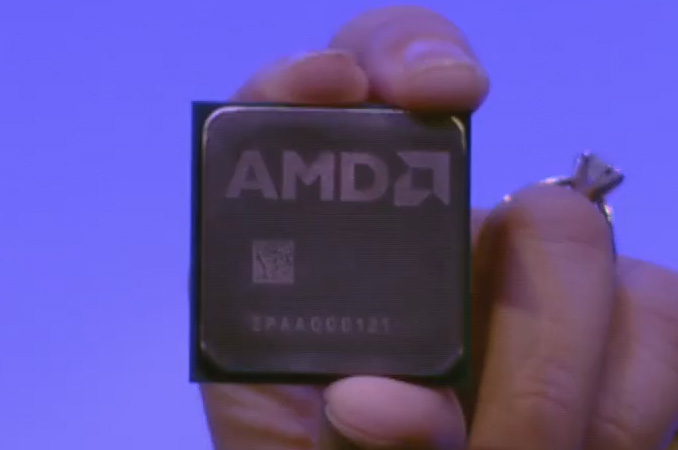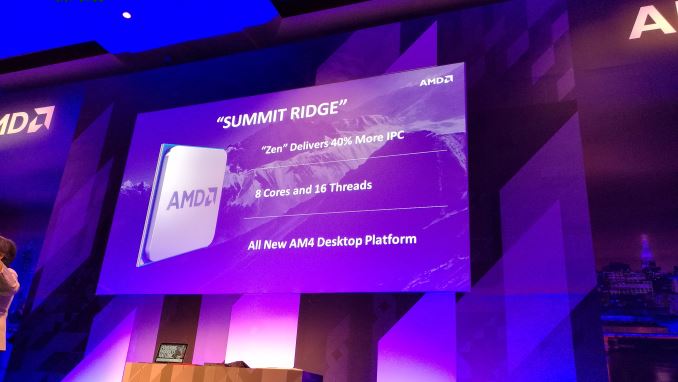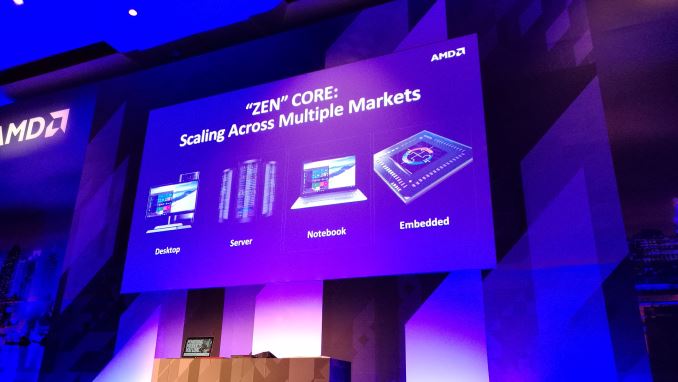AMD Briefly Shows Off Zen “Summit Ridge” Silicon
by Ryan Smith on May 31, 2016 11:15 PM EST- Posted in
- CPUs
- AMD
- Zen
- Computex_2016
- AM4

After an already packed Computex 2016 event with Radeon Polaris and Bristol Ridge/Stoney Ridge news, AMD CEO Dr. Lisa Su had one final surprise to close out the company’s presentation: Zen, in the flesh.
Zen taped out earlier this year, and AMD is now working on bringing it up in their labs. To that end Dr. Su pulled out a very early engineering sample of what will be AMD’s Summit Ridge CPU, an 8 core Zen-based CPU. Summit Ridge will use AMD’s new AM4 socket – currently being rolled out for Bristol Ridge – making it a drop-in platform replacement.
Little in the way of new details on Summit Ridge and Zen were released, but Dr. Su confirmed that AMD is still targeting a 40% IPC increase. On the development front, the chip still has some work to undergo, but AMD is to the point where they are going to start sampling their top-tier, high profile customers with engineering samples here in a few weeks. Wider sampling to their larger OEM base will in turn take place in Q3 of this year. AMD has not mentioned a retail product date, but keep in mind there’s a fairly significant lag time between OEM sampling and retail products.
Finally, Dr. Su also reiterated that Zen will be the basis of a range of products for AMD. Along with the desktop CPU, AMD will be using Zen as the basis of their next, 8th generation APU. And further down the line it will be appearing in server products and embedded products as well.












89 Comments
View All Comments
qap - Wednesday, June 1, 2016 - link
Then lets go as close as we can get:http://www.anandtech.com/bench/product/1291?vs=154...
Obviously - this is not "fair" in respect of price, but it is as close as it gets when you compare core-for-core with same frequency (=IPC). You can add few percent for improvements excavator brings over steamroller, but it doesn't change the picture. You would need WAY more than 40-50% to match Skylake even if we cherry-pick single-threaded tasks so we don't hurt AMD with their own definition of core.
caqde - Wednesday, June 1, 2016 - link
Actuallly given the zen architecture this would be inaccurate you would need to compete against a comparable skylake i3. So this -> http://www.anandtech.com/bench/product/1291?vs=164... would be a better comparison. Remember 1 Zen core = 1 Vishera Module. A10 7800 would be comparible to a Dual core Zen which would be compared to the i3 not i5. From what I can see Zen has two things going for it. The 40% IPC increase and the fixing of AMD's "Core count" in the view of the consumer. But anyways as seen in the benchmarks a 40% boost should make it comparable.JoeMonco - Wednesday, June 1, 2016 - link
Why would you compare to an i3 when the original question was in comparison to i7s?qap - Wednesday, June 1, 2016 - link
You are mistaking IPC with performance. AMD was talking about IPC and in that case there is NO equivalence 1 Zen Core = 1 Buldozer Module.My comparison was about IPC. You can take single-threaded (and also arguably dual-threaded) benchmarks from my link and add 40-50% and you get what AMD promises. And assuming AMD will achieve similar frequency as intel, it will not be enough to match performance per core (but it will take AMD from "pathetic" to "ok").
This assessment will apply to all single-threaded applications and also to all applications, that actively use less threads, than competing intel CPUs have cores (2 for i3 and 4 for i5/i7). We can only guess how it will scale beyond this because we have no idea about SMT implementation, thermal limits and other variables. It is probably good guess, that in massively multi-threaded apps like Cinebench 8-core Zen will come on top (v 4-core i7) ... but its only a guess.
jimjamjamie - Wednesday, June 1, 2016 - link
It's refreshing to see that not everyone is blindly perpetuating the AMD hype. The TDP hasn't even been mentioned yet.silverblue - Wednesday, June 1, 2016 - link
Cinebench? I'm not sure it's a particularly fair benchmark. Even so, the Bulldozer architecture was hamstrung by having a much narrower FPU interface. Zen is twice as wide. Some benchmarks will be above the 40% value, some will be less.psychobriggsy - Wednesday, June 1, 2016 - link
Well, floating point is not integer. Cinebench is probably a poor choice to compare CPU performance - you should be doing the work on a GPU anyway.Secondly, Zen will have 8 FPUs, compared to Bulldozer's 4, so there's your 50% in FP.
cotak - Thursday, June 2, 2016 - link
40% increase likely doesn't cut it like you suspect.More cores = more chip area. And chip area cost money. If you can deliver a competitive product with 4 cores you'd do that rather than shove out 8.
junky77 - Wednesday, June 1, 2016 - link
40% IPC + some gains from others stuff, like moving from the module architecture to the "classic" one. Add HT, add better cache and more stuff like that and you have a much faster than 40% CPU40% should be enough in order to have a GTX 1070 / Radeon Fury X with no CPU limitations in gaming scenarios, I think..
Spunjji - Wednesday, June 1, 2016 - link
Given that Sandy Bridge with an OC is still "good enough" in games this should have no problems :)